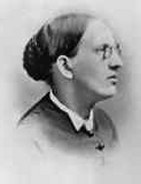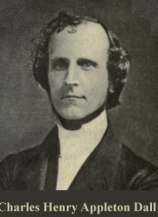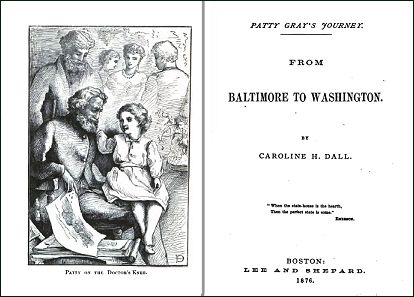
Caroline Wells Healey Dall
Although she is best known for her work and writings as a reformer, Caroline Dall also
authored one series for girls.
The eldest of eight children, Caroline Wells Healey was
born in Boston on 22 June 1822. Her parents, Mark Healey, a merchant, and Caroline (Foster)
Healey were well-to-do Unitarians. Educated by tutors and at Joseph Hale Abbot's School for
Girls, Healey began writing at an early age: indeed, her first publications -- "essays
on moral and religious subjects" -- were printed in newspapers and magazines while she was
still in her early teens. [1] By the late 1830s, she was also teaching Sunday School and
involved with a nursery to help the children of working women in Boston. These
interests -- writing, religion, education, and women's issues -- would remain central to her
life. She encountered another major influence in 1841, when she attended ten of Margaret
Fuller's "Conversations."

Circa 1840, Healey accepted a position in Georgetown, D.C.,
as vice-principal at Miss English's School for Young Ladies, working at the school
until 1844. During this time she was also involved with helping to educate free
African-Americans in Washington, D.C.
On 24 September 1844, Healey married
Charles Henry Appleton Dall, a Unitarian minister she had met while doing church work
in Boston. Their first child, William Healey Dall, was born in Boston on 21 August 1845;
their second child, Sarah Keene Healey Dall, was born in 1849, the same year Dall's first
book, Essays and Sketches, appeared. In 1850, Rev. Dall was assigned a position
in Toronto, where the family spent the next four years. While there, Mrs. Dall was active
n her husband's pastorate, taught a weekly class in religion, and worked with an organization
that helped fugitive slaves.
In 1854, Rev. Dall suffered a breakdown, prompting the
family's return to Boston. Then, in 1855, leaving his family behind, Rev. Dall became the
first Unitarian missionary to Calcutta. From 1855 until his death in July 1886, he lived
in Calcutta, briefly returning to the United
States at
five-year intervals. In his absence, Caroline Dall became more involved with women's
rights -- indeed, her biographical sketch in American National Biography suggests
that the problems -- financial and otherwise -- attendant upon supporting herself
and her children after her husband's departure may have played a significant role
in influencing Dall's philosophy and interest in women's rights.[2]

In the 1850s, Dall lectured and participated in women's rights conventions; for a time,
she also edited The Una, a women's rights journal. She began publishing books on
the subject in the 1860s, including Woman's Right to Labor (1860) [3] and
Woman's Rights Under the Law (1861). In 1865, she helped found the American
Social Science Association and remained on its executive committee for the next forty years.
1867 saw the publication of a book based on one of her lecture series, The College,
the Market, and the Court; or, Woman's Relation to Education, Labor, and Law, which
many consider her most important work.
Her only juvenile series, the
three-volume Patty Gray's Journey to the Cotton Islands,
appeared in 1869-70. According to Notable American Women, Dall had intended
to write six volumes but troubles with the publisher ended the series prematurely.
In an essay on Dall, Barbara Welter speaks of the series "which [Dall] admitted [was]
'chiefly autobiographical," characterizing it as "a triumph, almost an orgy, of
wish-fulfillment." [4]
In 1877, Dall was awarded an honorary LL.D. from Alfred
University, which, The National
Cyclopedia of American Biography noted,
"was well deserved, being the first given to a woman in modern times." Circa 1879,
she moved to Washington, D.C., where her son, a naturalist, was on the staff of the
Smithsonian. In later years, Dall continued to publish works of non-fiction for
adults on such varied topics as The Romance of the Association; or, One Last
Glimpse of Charlotte Temple and Eliza Wharton (1875), What We Really Know
About Shakespeare (1885; 1886), Margaret [Fuller] and Her Friends (1895).
She also penned two autobiographical works -- My First Holiday; or, Letters Home
from Colorado, Utah, and California (1881) and Alongside (1900), the latter,
an account of her childhood.
Caroline Dall died 17 December 1912.
Notes
[1] Steven Nissembaum, "Dall, Caroline Wells Healey," Notable
American Women, 1607-1950: A Biographical Dictionary. Vol. 1. Ed. Edward T. James.
(Belknap Press of Harvard UP, 1971): 429.
[2] Anne C. Rose, "Dall, Caroline Wells Healey," American National Biography..
Vol 6. Oxford UP, 1999.
[3] Available online
at Making of
America
[4] Barbara Welter, "The Merchant's Daughter," in Dimity Convictions
(Athens: Ohio UP, 1976):45. Welter adds that "Mrs. Gray . . . on occasion, represented
Caroline the adult as Patty was Caroline the model child" (55) and notes that the series
served as a vehicle for "a more personal statement of [Dall's] religious beliefs" (45).
Sources
"Dall, Caroline Wells Healey," Dictionary of American Biography. Vol. 5.
Scribner's, 1930.
"Dall, Caroline Wells Healey," National Cyclopedia of American
Biography. Vol. 9. James T. White, 1907.



